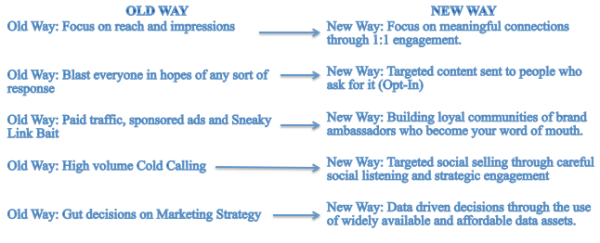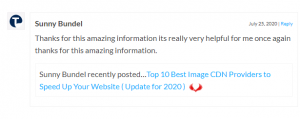By Dan Newman, Published October 23, 2014
You can almost picture yourself in the room. It’s the time of year again where the marketing team has to put together a strategy, a plan and a budget for the next fiscal year. After carefully considering the seismic shift that is happening across the digital web, the team has come back and said it is time to eradicate the marketing of old. Doing things differently is the only way. Our brand doesn’t need another year of stagnation pouring money into old media. Paid media has its place, but the time has come where people are building relationships with brands due to reasons greater than clever commercials and savvy product placement. Owned media, earned media and shared media have become “where it’s at.”
However, too often these days, the C-suite is not amused. Therefore they find holes in the “new way” as it is unproven, or lacks reach; but maybe it isn’t proof or reach at all that is to blame, but rather the lack of vision from the C-suite that is turning their back on the evolution of marketing?
Today, we have entered an economy where sharing is a de facto sign of endorsement and brand ambassadors are no longer just celebrities, but rather they are now Joe Average; the every day social media user that has a small yet defined audience of people who genuinely influence those in their circles.
This isn’t some kind of far off belief or ideology. It’s emphatically true. Study after study. From the Google Zero Moment of Truth to the analysts at Forrester and Nielsen, the trends are here and the buyer’s journey is changing, but this begs a question…What is your brand doing and more importantly is it evolving?
It’s The Way We’ve Always Done It…Because It Feels Good
Consultants rejoice because yes, these are some of the most dangerous words in business. But all too often the way we have always done it is comforting. There is a certain feeling of satisfaction that comes from doing what has always worked. Since the past is a tremendous indicator of future behavior, we have long found ourselves looking to the past for validation and as you know, what you seek to find in data can often be made to exist regardless of whether it truly represents the right decision.
In marketing, this window into the past is often used. Most notably when it comes to marketing strategy. Before big data, 1:1, omni-channel and the modern web, brands found their best means for gathering visibility was through media buys. This was reflected in newspaper, radio, television and then later became online advertisements in the form of banners, pop ups and other on page ads. Why did the first iteration of digital marketing evolve to be merely a recreation of old media online? We could suggest it was because of product evolution, but it is also difficult to say that there wasn’t a certain comfort in the metrics.
When we did media buys before digital we bought reach. Essentially we had rough ideas of reach and audience demographics so we knew how many people would see our ad. This followed suit on digital as we bought media there as well; spurring an onslaught of discussion on impressions and whether the words had any meaning. What for sure has meaning is that people don’t click banner ads so unless your ad is prevalent, targeted and memorable, your money may be wasted. Have you ever seen these data points on banner ads?
According to one business insider piece:
“You are 31.25 times more likely to win a prize in the Mega Millions than you are to click on a banner ad.” Not only that, “you are 87.8 times more likely to apply to Harvard and get in…112.50 times more likely to sign up for and complete NAVY SEAL training…279.64 times more likely to climb Mount Everest…and 475.28 times more likely to survive a plane crash than you are to click on a banner ad.”
However, it doesn’t stop because our lust for numbers just evolves. Even though no one is clicking we keep paying. And when it comes to social media our behavior followed suit.
- Invest time and money to grow our followers on Twitter or Instagram.
- Sponsored posts on Facebook or LinkedIn to increase our number of likes.
- Using 3rd Party Sponsored links to send traffic (unknowingly) back to your page
- The purchase of email lists to spam with unwanted content and emails
And the list goes on, but in short we aren’t evolving, only taking our short sighted media approach from yesteryear and plugging it into our go forward strategy because it feels good, because it is how it has always been done, because it is safe…but is it really?
Safety Will Arrive When Your Marketing Evolves
While the safety net that comes with “How it’s always been done” may provide a comfort, it is nothing more than an illusion because in the real world, we have reached a point where marketing must evolve.
Brands need to be thinking about the way they do digital, social and even traditional marketing in new ways. Because the old way has evolved and the new way looks more like this:
Of course there is a place for everything and before everyone starts throwing tomatoes just know that I recognize that Coca-Cola, Doritos and Citibank can benefit from widespread media reach. That is a default benefit from a globally recognized brand. However, also take not of this, the biggest brands with the most resources aren’t entirely dependent on the old way of doing media. And if you have any doubts just visit Coke Journey, American Express Open or IBM’s SMB community to see how marketing investment is being poured into more personalized, more direct marketing that connects brands to buyers with the intent to create a relationship, not a sale. The sale becomes a byproduct of everything else they do.
So when that next board meeting happens and the powers that be say no to marketing evolution and yes to more media buys and vanity metrics, stand up (if you aren’t afraid) and share with them the risk of doing the same and why the things that have worked in the past, will no longer work today.
Marketing must evolve, and comfort must be left in the rearview. The way things have always been done isn’t the way they should be done going forward. Unless you believe the consumer landscape hasn’t changed in the past 5-10 years. Oh, and in case you aren’t sure…It has.
Business Articles | Business 2 Community
(298)
Report Post







